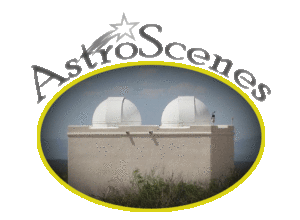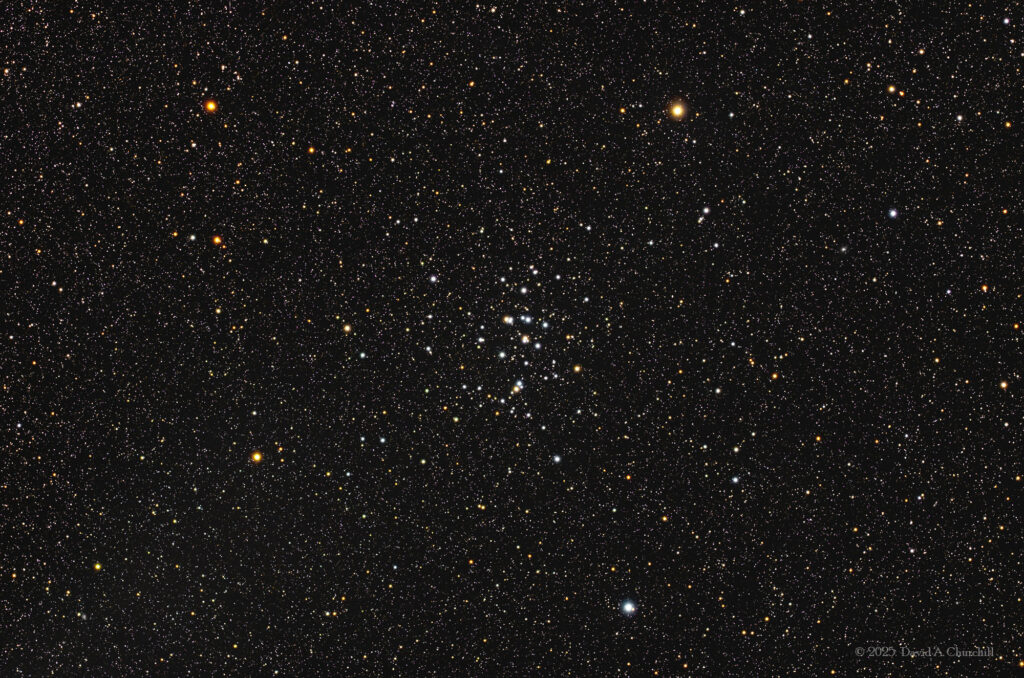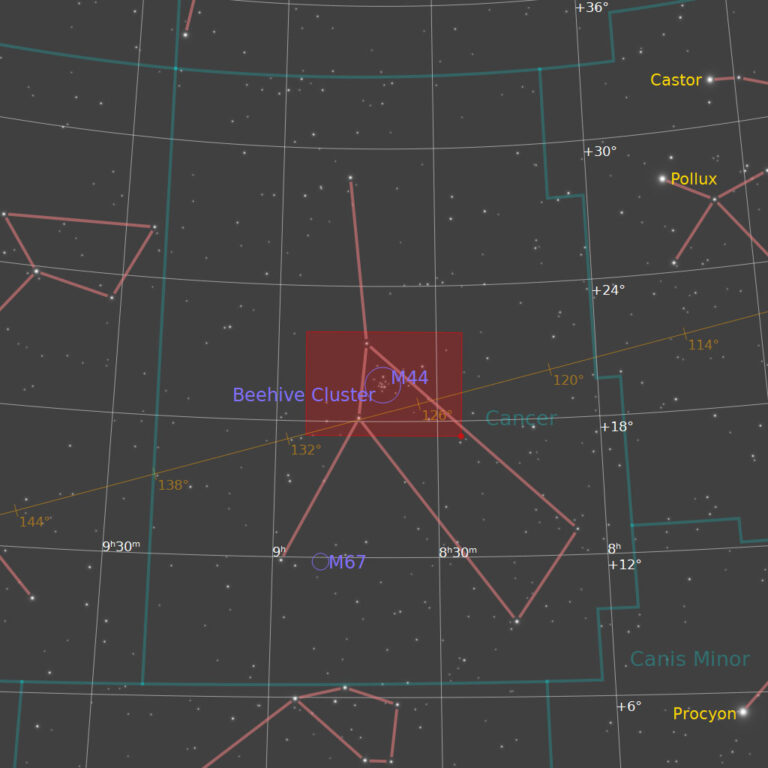Messier 44
Praesepe/Beehive Cluster. Open Cluster, Cancer
January 2025. Cave Creek Canyon Observatory, Arizona Sky Village
- Description
- Technical
- Links
The Beehive Cluster (also known as Praesepe (Latin for “manger”, “cot” or “crib”), M44, NGC 2632, or Cr 189), is an open cluster in the constellation Cancer. One of the nearest open clusters to Earth, it contains a larger population of stars than other nearby bright open clusters holding around 1,000 stars. Under dark skies, the Beehive Cluster looks like a small nebulous object to the naked eye, and has been known since ancient times. Classical astronomer Ptolemy described it as a “nebulous mass in the breast of Cancer”. It was among the first objects that Galileo studied with his telescope.
Age and proper motion coincide with those of the Hyades, suggesting they may share similar origins. Both clusters also contain red giants and white dwarfs, which represent later stages of stellar evolution, along with many main sequence stars. The distance to M44 is often cited to be between 160 and 187 parsecs (520–610 light years), but the revised Hipparcos parallaxes (2009) for Praesepe members and the latest infrared color-magnitude diagram favors an analogous distance of 182 pc. There are better age estimates of around 600 million years (compared to about 625 million years for the Hyades). The diameter of the bright inner cluster core is about 7.0 parsecs (23 light years).
At 1.5° across, the cluster easily fits within the field of view of binoculars or low-powered small telescopes. Regulus, Castor, and Pollux are guide stars. In 1609, Galileo first telescopically observed the Beehive and was able to resolve it into 40 stars. Charles Messier added it to his famous catalog in 1769 after precisely measuring its position in the sky. Along with the Orion Nebula and the Pleiades cluster, Messier’s inclusion of the Beehive has been noted as curious, as most of Messier’s objects were much fainter and more easily confused with comets. Another possibility is that Messier simply wanted to have a larger catalog than his scientific rival Lacaille, whose 1755 catalog contained 42 objects, and so he added some well-known bright objects to boost his list. Wilhelm Schur, as director of the Göttingen Observatory, drew a map of the cluster in 1894.
Ancient Greeks and Romans saw this object as a manger from which two donkeys, the adjacent stars Asellus Borealis and Asellus Australis, are eating; these are the donkeys that Dionysos and Silenus rode into battle against the Titans. Hipparchus (c.130 BC) refers to the cluster as Nephelion (“Little Cloud”) in his star catalog. Claudius Ptolemy’s Almagest includes the Beehive Cluster as one of seven “nebulae” (four of which are real), describing it as “The Nebulous Mass in the Breast (of Cancer)”. Aratus (c.260–270 BC) calls the cluster Achlus or “Little Mist” in his poem Phainomena. Johann Bayer showed the cluster as a nebulous star on his Uranometria atlas of 1603, and labeled it Epsilon. The letter is now applied specifically to the brightest star of the cluster Epsilon Cancri, of magnitude 6.29.
Altogether, the cluster contains at least 1000 gravitationally bound stars, for a total mass of about 500–600 Solar masses. A recent survey counts 1010 high-probability members, of which 68% are M dwarfs, 30% are Sun-like stars of spectral classes F, G, and K, and about 2% are bright stars of spectral class A. Also present are five giant stars, four of which have spectral class K0 III and the fifth G0 III. So far, eleven white dwarfs have been identified, representing the final evolutionary phase of the cluster’s most massive stars, which originally belonged to spectral type B. Brown dwarfs, however, are rare in this cluster, probably because they have been lost by tidal stripping from the halo. A brown dwarf has been found in the eclipsing binary system AD 3116.
The cluster has a visual brightness of magnitude 3.7. Its brightest stars are blue-white and of magnitude 6 to 6.5. 42 Cancri is a confirmed member.
Age and proper motion coincide with those of the Hyades, suggesting they may share similar origins. Both clusters also contain red giants and white dwarfs, which represent later stages of stellar evolution, along with many main sequence stars. The distance to M44 is often cited to be between 160 and 187 parsecs (520–610 light years), but the revised Hipparcos parallaxes (2009) for Praesepe members and the latest infrared color-magnitude diagram favors an analogous distance of 182 pc. There are better age estimates of around 600 million years (compared to about 625 million years for the Hyades). The diameter of the bright inner cluster core is about 7.0 parsecs (23 light years).
At 1.5° across, the cluster easily fits within the field of view of binoculars or low-powered small telescopes. Regulus, Castor, and Pollux are guide stars. In 1609, Galileo first telescopically observed the Beehive and was able to resolve it into 40 stars. Charles Messier added it to his famous catalog in 1769 after precisely measuring its position in the sky. Along with the Orion Nebula and the Pleiades cluster, Messier’s inclusion of the Beehive has been noted as curious, as most of Messier’s objects were much fainter and more easily confused with comets. Another possibility is that Messier simply wanted to have a larger catalog than his scientific rival Lacaille, whose 1755 catalog contained 42 objects, and so he added some well-known bright objects to boost his list. Wilhelm Schur, as director of the Göttingen Observatory, drew a map of the cluster in 1894.
Ancient Greeks and Romans saw this object as a manger from which two donkeys, the adjacent stars Asellus Borealis and Asellus Australis, are eating; these are the donkeys that Dionysos and Silenus rode into battle against the Titans. Hipparchus (c.130 BC) refers to the cluster as Nephelion (“Little Cloud”) in his star catalog. Claudius Ptolemy’s Almagest includes the Beehive Cluster as one of seven “nebulae” (four of which are real), describing it as “The Nebulous Mass in the Breast (of Cancer)”. Aratus (c.260–270 BC) calls the cluster Achlus or “Little Mist” in his poem Phainomena. Johann Bayer showed the cluster as a nebulous star on his Uranometria atlas of 1603, and labeled it Epsilon. The letter is now applied specifically to the brightest star of the cluster Epsilon Cancri, of magnitude 6.29.
Altogether, the cluster contains at least 1000 gravitationally bound stars, for a total mass of about 500–600 Solar masses. A recent survey counts 1010 high-probability members, of which 68% are M dwarfs, 30% are Sun-like stars of spectral classes F, G, and K, and about 2% are bright stars of spectral class A. Also present are five giant stars, four of which have spectral class K0 III and the fifth G0 III. So far, eleven white dwarfs have been identified, representing the final evolutionary phase of the cluster’s most massive stars, which originally belonged to spectral type B. Brown dwarfs, however, are rare in this cluster, probably because they have been lost by tidal stripping from the halo. A brown dwarf has been found in the eclipsing binary system AD 3116.
The cluster has a visual brightness of magnitude 3.7. Its brightest stars are blue-white and of magnitude 6 to 6.5. 42 Cancri is a confirmed member.
Telescope: Askar FRA300pro f5
Mount: Astro Physics Mach-1
Camera: ZWO ASI6200MC pro
Guider: ZWO Off-Axis-Guider / ZWO120MM Mini
Filters: None. Integrated ZWO UV/IR Cut Filter Cover
36×5 mins = 180 mins
Total Imaging Time: 3h 00m
Data Imaged remotely on 1 night during January 2025.
Data acquisition & Processing by David Churchill.
None


